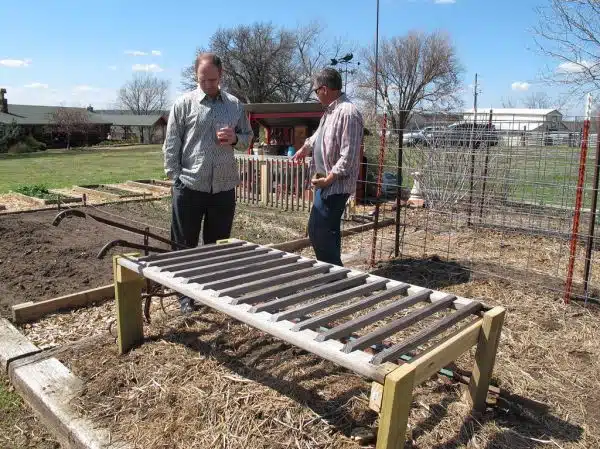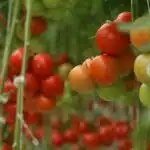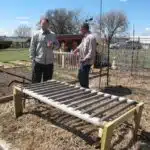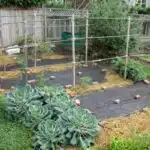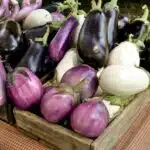Tomatoes are one of the most popular vegetables grown in home gardens and commercial farms worldwide. The fruit is rich in vitamins, minerals and antioxidants, making it a healthy addition to any diet. However, growing tomatoes can be challenging in hot climates due to the high temperatures and dry weather conditions that can affect plant growth and fruit production. As a horticulturalist or agricultural expert, it is important to understand the best practices for successfully cultivating tomatoes in hot climates.
In this article, we will explore the essential tips for growing tomatoes in hot climates. We will discuss how to select the right tomato varieties that are suited to hotter regions, how to prepare the soil for planting, how to water and fertilize plants effectively, as well as how to protect them from common pests and diseases. By following these guidelines, you can increase your chances of achieving a bountiful tomato harvest that will not only satisfy your own needs but also those of your community.
Understanding The Challenges Of Growing Tomatoes In Hot Climates
Growing tomatoes in hot climates can pose a significant challenge to gardeners and farmers alike. The arid environment, coupled with high temperatures, can lead to water stress, sunburn, and pests that thrive in dry conditions. To overcome these obstacles, it is crucial to understand the unique challenges of growing tomatoes in hot climates.
One of the most critical factors to consider when growing tomatoes in hot climates is irrigation systems. In these areas, water is scarce and precious, and proper irrigation techniques are essential for healthy plant growth. Drip irrigation systems provide an efficient way to water plants while minimizing evaporation and runoff. Additionally, using mulch around the base of tomato plants can help retain moisture in the soil.
Another option to consider when growing tomatoes in hot climates is shade structures. These structures can protect tomato plants from direct sunlight during peak hours by blocking out some of the sun’s rays. Shade cloths or netting can be used to cover plants partially or entirely, depending on the severity of the heat. Proper shading not only helps prevent sunburn but also promotes healthy plant growth by reducing water loss through transpiration.
To successfully grow tomatoes in hotter regions, it is essential to understand the challenges associated with this environment and take necessary steps to mitigate them. The next step towards achieving optimal results involves selecting suitable tomato varieties that are better adapted to challenging conditions like high temperatures and low moisture levels.
Choosing The Right Tomato Varieties For Hotter Regions
Understanding the challenges of growing tomatoes in hot climates is essential before choosing the right tomato varieties. One of the main issues is that high temperatures and humidity can cause blossom drop, which means the flowers fall off before fruit sets. Additionally, heat stress can stunt growth and reduce yield. Therefore, it is crucial to select tomato varieties that are heat-tolerant and can withstand these conditions.
When it comes to choosing the best varieties for hot regions, several factors should be considered. Firstly, look for indeterminate varieties as they tend to produce fruit throughout the season compared to determinate varieties that produce fruit all at once. Secondly, choose those with a short maturity period since they will have enough time to ripen before the end of the season. Thirdly, check for disease resistance as this will ensure better yield and quality of fruits. You can find these varieties from reliable seed suppliers who specialize in providing seeds suited for hotter regions.
There are several seed suppliers who offer a wide range of tomato varieties suitable for hot climates. Some popular ones include Burpee, Baker Creek Heirloom Seeds, and Territorial Seed Company. These companies offer different types of tomatoes such as cherry tomatoes, beefsteak tomatoes, and heirloom tomatoes that are ideal for hotter regions. Before purchasing your seeds, make sure you read reviews about the supplier’s reputation and check if they have any additional recommendations on how to grow their seeds successfully.
In conclusion, selecting the right tomato variety is crucial when growing in hot climates. Look for indeterminate varieties with a short maturity period and disease resistance from reputable seed suppliers like Burpee or Territorial Seed Company. In our next section, we will discuss how preparing your soil for tomato planting can increase your chances of success when growing tomatoes in hotter regions without relying on fertilizers or pesticides heavily.”
Preparing Your Soil For Tomato Planting
Successful tomato growing in hot climates begins with preparing the soil. The first step is to choose a location that receives at least 6-8 hours of direct sunlight per day. Once you have chosen your spot, it’s time to start preparing the soil. Composting is a great way to improve the quality of your soil and provide your tomatoes with the nutrients they need.
Composting benefits your plants by enriching the soil and improving its structure. It provides organic matter which helps retain moisture, improves drainage, and promotes healthy root development. Additionally, composting can help reduce diseases in your garden while increasing beneficial bacteria that helps ward off pests.
To prepare your soil for planting tomatoes, you will need some basic tools such as a spade or fork, rake, and hoe. Remove any weeds or debris from the area where you plan to plant. Then loosen the soil to a depth of at least 12 inches with your spade or fork. Rake out any clumps or rocks until the surface is smooth and level.
Overall, preparing your soil with composting benefits and using proper tools is essential for successful tomato growing in hot climates. In the next section, we will discuss how to plant and care for tomato seedlings so that you can enjoy juicy ripe tomatoes all season long!
Planting And Caring For Tomato Seedlings
- Tomato seedlings are best sown in late spring in warm climates and in early spring in colder climates.
- Seedlings should be transplanted when they reach 3-4 inches in height, as this allows for better root development.
- After transplanting, tomato seedlings should be watered regularly and should receive 1-2 inches of water per week.
- Tomatoes should be planted in a sunny area and should be fertilized every two weeks to ensure adequate nutrient supply.
- Weeds should be removed regularly to reduce competition for water and nutrients.
- To protect the plants from pests and diseases, a mulch layer should be applied around the plants.
Sowing Seeds
To successfully grow tomatoes in hot climates, it is important to pay close attention to sowing the seeds. Seed starting tips include using a good quality potting mix that provides adequate drainage and moisture retention, as well as planting the seeds at the appropriate depth. It is also recommended to start the seeds indoors about 6-8 weeks before the last expected frost date in your area.
Soil temperature management plays a critical role in successful seed germination. Tomato seeds generally require a soil temperature of around 70-80°F for optimal germination. It is therefore important to ensure that the soil temperature remains consistent and within this range throughout the germination period. This can be achieved by using a heating mat or placing the seed trays in a warm area such as near a sunny window or on top of a refrigerator.
In addition, it is important to keep the soil moist but not too wet during germination. Overwatering can lead to fungal diseases and rotting of the seeds, while underwatering can cause them to dry out and die. With proper seed starting techniques and soil temperature management, you can ensure healthy and vigorous tomato seedlings that will thrive in hot climates.
Transplanting Seedlings
After successfully growing tomato seedlings indoors, it is time to transplant them into their final outdoor location. Timing considerations are important when it comes to transplanting seedlings. Tomato seedlings should be transplanted outdoors after the last expected frost date in your area. Transplanting earlier than this can lead to damage or death of the seedlings due to cold temperatures.
Before transplanting, it is important to prepare the soil by adding organic matter such as compost or aged manure. This will help improve soil structure and fertility, which in turn will promote healthy growth of tomato plants. When transplanting, make sure to plant the seedlings deep enough so that only the top few leaves are above ground level. This will encourage a strong root system to develop.
The hardening off process should also be considered before transplanting tomato seedlings outdoors. Hardening off involves gradually introducing the seedlings to outdoor conditions such as sunlight, wind, and temperature changes over a period of 7-10 days. This helps acclimate the plants to their new environment and reduces shock from sudden changes in conditions. Proper timing considerations and hardening off techniques can ensure a successful transition for tomato seedlings from indoor growing to thriving outdoor plants.
Caring For Plants
After successfully transplanting tomato seedlings outdoors, it is important to continue caring for them to ensure their growth and productivity. One option for those with limited outdoor space is container gardening. Tomatoes can be grown in containers as long as they have sufficient drainage and proper soil mix. When growing tomatoes in containers, it is important to provide support such as stakes or cages to prevent the plants from bending or breaking under the weight of fruit.
Companion planting is also an important aspect of caring for tomato plants. Certain plants, such as basil and marigolds, can help deter pests and improve the overall health of tomato plants when planted nearby. However, other plants such as potatoes and fennel should be avoided as they can attract pests or compete for resources with tomato plants.
In addition to companion planting, regular care practices such as watering and fertilizing are essential for healthy tomato plant growth. Tomatoes require consistent moisture but can suffer from overwatering, so it is important to find a balance. Fertilizer should be applied according to instructions on the product label and should not be overused as excess nutrients can harm the plants. With proper care practices including container gardening and companion planting, tomato plants have the potential to thrive and produce bountiful harvests.
Watering Techniques For Hot Climates
Tomato seedlings require a great deal of care and attention in their early stages. Once they are planted, it is important to continue providing them with the necessary care to ensure optimal growth. In hot climates, this can be challenging due to the high temperatures and lack of rainfall. However, by implementing certain techniques, it is possible to successfully grow tomatoes even in these conditions.
One of the most important factors to consider when growing tomatoes in hot climates is irrigation. Drought resistant irrigation methods such as drip irrigation and soaker hoses can help conserve water while still providing the plants with the moisture they need. It is also important to water deeply and infrequently rather than frequently and shallowly, as this encourages deep root growth which helps the plants better withstand drought conditions.
Another technique that can be useful in hot climates is mulching. Mulching helps retain moisture in the soil, keeps roots cool during hot weather, and suppresses weeds that compete for water and nutrients. Organic materials such as straw or leaves can be used for mulch, but plastic mulch may also be effective in areas with high evaporation rates.
To successfully grow tomatoes in hot climates, it requires careful planning and diligent implementation of various techniques. By utilizing drought resistant irrigation methods and incorporating mulching techniques into your gardening practices, you can help your tomato plants thrive even in harsh conditions. In the next section, we will explore fertilizing options for optimal tomato growth.
Fertilizing Tomatoes For Optimal Growth
Tomatoes require a balanced and consistent supply of nutrients to achieve optimal growth. Fertilizers are an essential component of tomato cultivation, especially in hot climates where water evaporation rates are high. Organic fertilizers consist of natural substances such as compost, manure, and bone meal while synthetic fertilizers comprise inorganic compounds like ammonium nitrate and potassium sulfate. Organic fertilizers improve soil structure, promote microbial activity, and enhance soil fertility over time. Synthetic fertilizers offer a quick nutrient fix but do not improve the soil’s overall health.
Foliar feeding is another technique used to supplement tomato plants with nutrients. This technique involves spraying fertilizer solutions directly onto the leaves’ surface to deliver micronutrients like magnesium, zinc, and iron. Foliar feeding can be done using organic or synthetic fertilizers depending on the grower’s preference. The main advantage of foliar feeding is that it provides immediate results since the nutrients are absorbed quickly through the leaves into the plant’s system.
In summary, fertilizer application is crucial for growing healthy and productive tomato plants in hot climates. Growers can choose between organic and synthetic fertilizers based on their preferences and needs. Additionally, foliar feeding can be used as a complementary technique alongside traditional soil-based fertilization methods to provide an extra boost of nutrients when needed. Understanding these techniques will help growers maximize their yields and produce high-quality tomatoes even in harsh climatic conditions.
Moving forward into managing common tomato pests and diseases, it is important to stay vigilant about potential issues that could harm your crop.
Managing Common Tomato Pests And Diseases
Tomatoes are one of the most widely grown vegetables across the world. However, they are susceptible to a variety of pests and diseases that can reduce yield and quality. Early detection and prevention measures are crucial in managing common tomato pests and diseases.
One effective method of controlling tomato pests is through organic solutions such as neem oil, garlic spray, or insecticidal soap. These methods are safe for the environment and have been proven to be effective in reducing pest populations. In addition, practicing crop rotation can help prevent the buildup of soil-borne diseases such as verticillium wilt and fusarium wilt.
Effective pesticides should also be used as a last resort in managing tomato pests and diseases. It is important to choose a pesticide that specifically targets the pest or disease without harming beneficial insects such as bees. Always follow label instructions carefully when using pesticides to ensure their effectiveness and reduce potential harm to humans and the environment.
Moving forward, early detection remains crucial in managing common tomato pests and diseases. Regularly inspecting plants for signs of infestation or disease can help prevent further spread. In addition, preventative measures such as providing adequate nutrition, water, and sunlight can help strengthen plants against potential threats before they become severe. By implementing these strategies, gardeners can successfully grow healthy tomatoes even in hot climates.
Transition sentence: To further enhance tomato productivity during growth stage, it is essential to understand how pruning and supporting techniques work together to optimize space utilization by maintaining plant health while stimulating optimal fruit production.
Pruning And Supporting Tomato Plants
Pruning involves the removal of unwanted shoots and stems from tomato plants in order to encourage the growth of more useful and fruiting branches. Supporting tomato plants involves the use of stakes, cages, or training techniques to provide structure and stability to the plant. Pruning practices should be used judiciously to allow for healthy growth and fruiting, while fertilizing and mulching can help to improve soil quality and retain moisture. Providing adequate sunlight, watering, and disease and pest control measures can also help to ensure the successful growth of tomatoes in hot climates.
Pruning
Pruning is an essential aspect of growing healthy and productive tomato plants in hot climates. There are two basic types of pruning: determinate and indeterminate. Determinate tomatoes grow to a certain size then stop, while indeterminate tomatoes continue to grow throughout the season. For determinate plants, it’s best to prune only the bottom leaves that touch the ground to prevent diseases from spreading. Indeterminate plants require more attention as they benefit from regular pruning to promote airflow, light penetration, and fruit production.
Pruning frequency is crucial when growing tomatoes in hot climates. It’s recommended to start pruning when tomato plants have grown three or four sets of true leaves. Once you start pruning, you should do it regularly every 7-10 days to control growth and promote fruit production. However, be cautious not to over-prune as this can negatively affect plant growth and yield. You can prune your tomato plants until there are only one or two stems left for indeterminate varieties.
In conclusion, proper pruning is essential for growing healthy tomato plants in hot climates. There are two types of pruning: determinate and indeterminate, with the latter requiring more attention compared to the former. Pruning frequency is also crucial as it helps control growth and promotes fruit production without over-pruning. By following these practices, you can expect a bountiful harvest of juicy tomatoes despite the scorching heat of summer!
Supporting
After discussing the importance of pruning tomato plants in hot climates, it’s time to tackle another essential aspect of growing tomatoes – supporting. Tomato support structures and trellising techniques are crucial for ensuring plants grow upright and produce healthy fruits.
Tomato plants require adequate support to prevent them from falling over or breaking under the weight of their fruits. There are several tomato support structures available, including cages, stakes, and trellises. Cages offer excellent support for determinate varieties, while indeterminate varieties benefit more from stakes or trellises that allow them to climb upwards.
Trellising techniques involve training tomato plants to grow vertically along a structure like a fence or stake. This technique not only saves space but also promotes better air circulation around the plant, reducing the risk of diseases. When using trellises, it’s essential to prune regularly and tie up any branches that may start drooping or leaning towards one side. With proper support and trellising techniques, you can expect healthy tomato plants with a bountiful yield.
Harvesting And Storing Tomatoes
After pruning and supporting your tomato plants, it is time to reap the rewards of your hard work. Harvesting tomatoes at their peak ripeness is crucial to get the best flavor and texture from them. When harvesting, use a sharp knife or pruning shears to cut the stem just above the fruit, leaving a small piece of stem attached. This will prevent any damage to the fruit and help them last longer.
Once you have harvested your tomatoes, it’s important to know how to store them properly. Tomatoes can be stored at room temperature away from direct sunlight until they are fully ripe. Once ripe, they can be stored in the refrigerator for up to a week. However, refrigeration can affect their flavor and texture, so it’s best to use ripe tomatoes within a few days.
If you find yourself with an abundance of ripe tomatoes, there are many preserving methods you can use such as canning or freezing. You can also make delicious tomato recipes such as salsa, marinara sauce or even tomato jam! These recipes not only allow you to enjoy your harvest throughout the year but also provide an opportunity for sharing with others in your community who may not have access to fresh produce.
As you share your tomato harvest with the community, consider starting a neighborhood garden where others can grow their own fruits and vegetables. This not only promotes healthy eating habits but also fosters a sense of community and connection among neighbors. By working together and sharing resources, we can create a more sustainable future for all.
Sharing Your Tomato Harvest With The Community
Community involvement is an essential aspect of gardening. It brings people together and fosters a sense of belongingness. One way to contribute to the community is by sharing surplus tomatoes from your garden. This not only helps to reduce food waste but also provides fresh produce to those who may not have access to it.
Sharing your tomato harvest can be done in different ways. One option is to set up a stand in your neighborhood and give away tomatoes for free. This allows you to connect with your neighbors and promote healthy eating habits. Another way is to donate your surplus tomatoes to local food banks or shelters. Many organizations are always in need of fresh produce, and your contribution can make a significant impact.
If you want to take community involvement a step further, you can even organize a tomato festival or a canning workshop. This provides an opportunity for people in the community to come together, learn new skills, and enjoy the delicious fruits of their labor. By sharing your knowledge and resources with others, you are contributing towards building a stronger and healthier community.
Remember that gardening is not just about growing plants; it’s about connecting with people and giving back to the community. By sharing your surplus tomatoes, you are making a positive impact on people’s lives while promoting healthy eating habits. So don’t hesitate to get involved and share the bounty of your garden with others!
Conclusion
Growing tomatoes in hot climates can be a challenging task, but with the right techniques and knowledge, it is possible to successfully cultivate these juicy fruits. It is essential to choose the appropriate tomato varieties that are well-suited for hotter regions and prepare the soil accordingly. Adequate watering techniques must be employed to ensure that the plants receive enough moisture while preventing waterlogging.
Pruning and supporting tomato plants as they grow will mitigate damage from pests and diseases, leading to a more bountiful harvest. Proper storage is necessary to retain the quality of harvested tomatoes, and sharing them with one’s community can foster a sense of belongingness while promoting healthy eating habits. With these tips, growing tomatoes in hot climates can be both fruitful and rewarding. So go ahead and enjoy the delicious taste of homegrown tomatoes!
Image Credits
- “Growing Tomatoes” by OakleyOriginals (featured)

